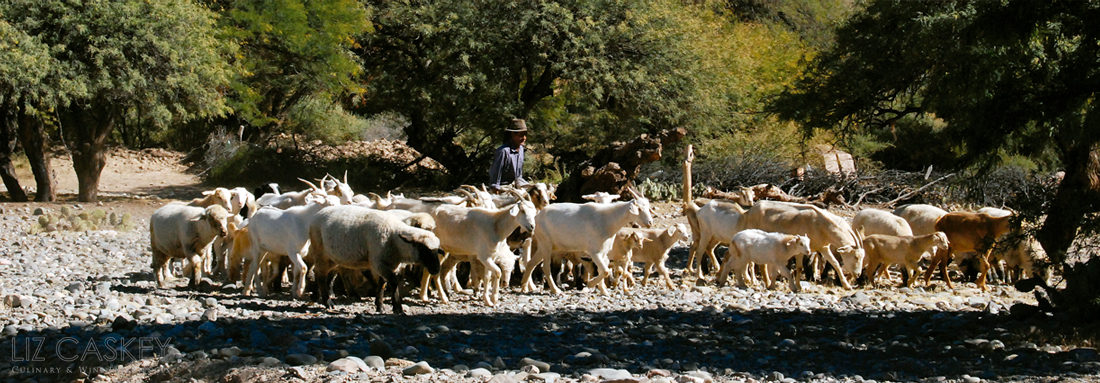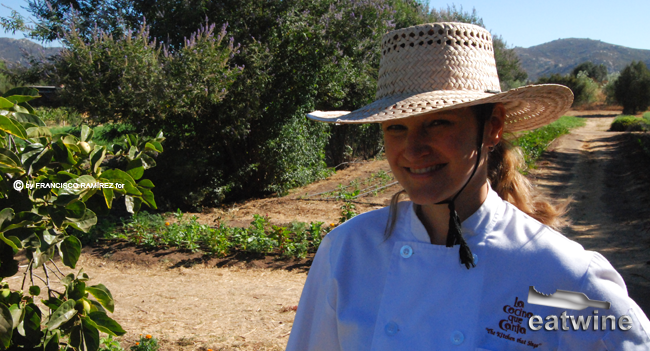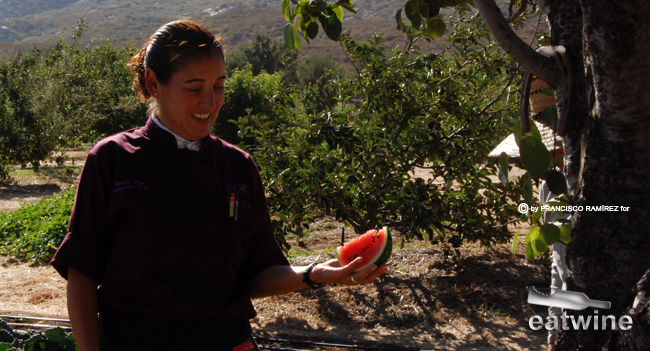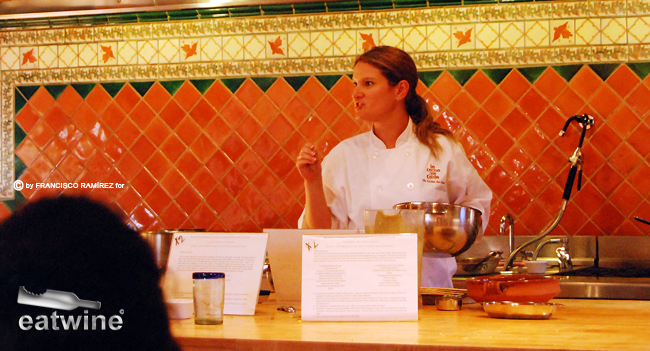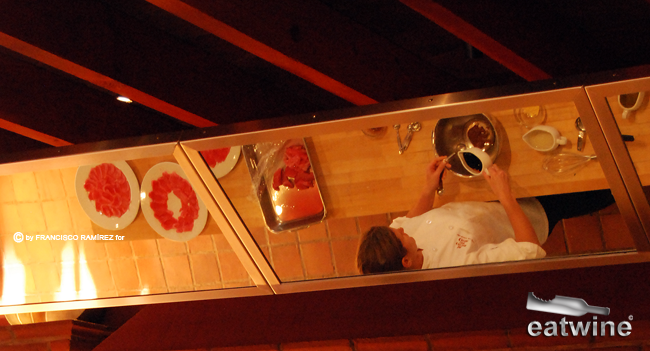The starting point of our RTW trip was, fittingly, at a fitness spa in Baja Mexico, Rancho La Puerta, where I was invited to be guest chef on South American cuisine at their cooking school, La Cocina que Canta. To call Rancho La Puerta simply a spa is rather dismissive. It’s more a fitness resort, a retreat, a (fun) escape from daily life. It’s a place to recharge, regroup, reboot your system, relax, rest, get inspired, and even sharpen up your cooking skills.
We arrived in San Diego after one of the most grueling, un-fun flights on American in years. After what seemed like an eternal wait in the airport in an extremely sleep deprived, semi jet-lagged state, we were on our way down a twisty turny road into San Diego Canyon country (err, desert) heading towards the small border town of Tecate. As we drove, I admired the steep hillsides dented with Flinestoneian boulders. Small woodsheds bore intriguing signs like “Rattlesnack eggs” (what on earth would you do with that? Eat it?). Francisco and I were instantly imagining Ruta 5 Norte in Chile heading towards La Serena from Santiago. I have constant deja vous on the west coast of the US, truly Chile’s northern geographical cousin.
Arriving (finally!) at Rancho La Puerta, the smells overtook me immediately. Fragrant gardens at every bend burst with flowers, rosemary, and sage. The place seemed to expand indefinitely in a network of brick paths, and we couldn’t wait to explore—after a siesta. Completely bushed from the trip, we defrosted from the Chilean winter in the warm Mexican sun on the terrace of our Villa, beginning to tan our pasty white bodies (well, mine at least).
If this was a taste of the relaxed state the “Ranch” induces, we were ready and willing. It was a week of intense physical activity—6 a.m. mountain hikes before breakfast, pilates, training circuits, zumba, yoga, core workouts, sculpting. I think we worked out an average of 4 hours per day. After lunch, the days I didn’t give cooking classes, we’d find a couple of the many hammocks strategically placed under ancient oak trees or pines and snooze in the shade as the afternoon breeze quietly rustled the leaves. I disappeared sometimes to let the masseuse knead my muscles back to normal and decompress in the steam room. We tanned, swam, read, and were in bed most nights after a hot tub run by 8:30-9pm since wake-up was before dawn. The vegetarian food was delicious. Real food exploding with vitality, freshness, and flavor. It was the kind of food that left you feeling light and energized as if you were putting the right “gas” into your machine/body. I did find out at dinner the first night there was no alcohol. I don’t know why I was so surprised by this but I had assumed wine would at least be served with dinner. No biggie. By day 3, I had completely forgotten about it and knew we’d be making up for it in Napa afterwards, our next stop.
As chef, the highlight by far was giving the cooking classes at the nearby cooking school La Cocina que Canta. Not only is this is a beautiful, traditional Mexican-style cooking school (with every imaginable convenience in their kitchen), it also has a 6-acre organic vegetable garden called Tres Estrellas. Run by executive chef Denise Roa (pictured in the photo above), I was very inspired from the get go when she sent me a spreadsheet of the produce that would be available from their garden during my week at the Ranch a month prior to my arrival.
I was greeted by the head gardener, Salvatore, who spoke in rapid Mexican Spanish. Soon leaving on vacation but eager to show me his work, we were also accompanied into the field by the charming head feline, Lizard. We walked past trees laden with figs, pears, and stone fruits, soon to be ripe. As we brushed past the tomato plants, Denise regreted the state of the immature tomatoes in late July. Apparently the cold nights were stunting the maturation process and August would surely be a full on tomatina. We walked through rows of basil, five different kinds, stopping to clip them into a basket. I instantly fell in love with cinnamon basil. Spicy, herbaceous, seductive, I imagined how this would make a racy pesto. Salvatore stopped to whack off a round watermelon shaped like a small basketball with his knife. He cut me a piece and I stood there sucking up the sweet, sticky watermelon goodness, still warm from the sunshine. The vegetables and fruits here are truly alive. They have life force. Vitality. They have an amazingly pure flavor. The corn is sweet, the cucumbers have a fragrant aroma and distinctive crispness. You feel good eating them and you know it’s what your body need, wants, and craves. Real food–what a concept!
The garden certainly is a highlight not only for cooking class participants but guests, too. Several mornings during the week there’s an Organic garden breakfast hike where guests can visit and experience this farm-to-table concept first hand. I truly believe it is such an important connection to see how our food grows (organically!), to understand nature’s cycles, to eat with the seasons, and to experience how the land provides so abundantly for us. In Chile, I often pinch myself for how lucky we are with all the local farms and abundant farmers markets, something I think we often take for granted. When I visit the US, I am quickly reminded how much of the “industrialized” world is completely disconnected with its food source. I admire how this cooking school has put that basic link back into the equation and made it accessible to guests. It is not that it doesn’t exist in the US, but it’s certainly a choice that must be sought out.
The classes were a lot of fun to teach since the style is completely hands-on cooking. While the awesome sous chefs helped get the mise en place ready for everyone, the guests were divided according to their interest in preparing certain recipes coupled with cooking experience and skills they wanted to learn. While I love demo-ing for different reasons, to learn new foods, particularly ethnic cuisine, getting your hands dirty is the best way to go.
Tuesday we focused on Peruvian cuisine with classic ceviche, tiradito, “solterito” fava bean Salad from Arequipa (my fav!), quinoa and hearts of palm salad, Andean roasted potatoes with a duo of sauces (huacatay and salsa criolla), vegetable escabeche, and roasted fresh figs with homemade Ricotta. On Thursday’s Gluten Free class, we focused on Chile’s Mediterranean-style cuisine with an Argentine recipe thrown in: Shrimp pil pil, roasted pepper soup with basil-corn muffins, Herbed cranberry bean salad with caramelized leeks, Chilean-style tomato salad, Savory Argentine humita (corn pudding), and strawberries (from the garden) with red wine sauce and cinnamon basil. The food was varied and surprised guests with the unique flavor combinations, abundant use of produce, and very little oil (yes, obviously cooking lessons at a spa were not the stage for fried cheese empanadas…).
What I most took away from the experience was re-embracing and reinforcing healthy living philosophies that we live by at home: drink liters of fresh (filtered) water, exercise daily, get tons of oxygen (breathe deeply!), eat lots of fresh veggies and go vegetarian at least 3 days per week. Exercise portion control (this was huge), and relax. Life is not meant to be overly serious. We make it way too serious. It’s meant to be fun, exciting, connective. Too often daily life turns living into a chore. The Ranch’s powerful mission is reconnecting us to ourselves through nature in every sense. I am a total fan and hope to return to join the many who make the trip every year.
Recipe for Tuna Tiradito, Nikkei-Style
During the first class I gave on Peruvian cuisine, we had an emergency when the Ají Amarillo paste didn’t arrive. For those of you familiar with this chili paste it’s essentially the soul, life line, and blood of making a traditional Tiradito dressing. Crap…what to do? Get creative. Inspired from a recent group dinner at Ache restaurant in Lima, specializing in Nikkei cuisine (Peruvian-Japanese fusion), the lightbulb went off. Tuna Tiradito, Nikkei-style. Chef Denise emerged with two sashimi-grade, ruby red tuna loins and Gaby, the sous chef, confirmed all the other ingredients were on hand. Saved by the walk-in freezer and a personal obsession with Nikkei cuisine. This tiradito is quite easy to make at home but the key is in having immaculate sashimi-grade tuna–and cutting it on the right angle. It should melt in your mouth and barely have to chew it. In the photo above you can see how it’s arranged on the plate as I mix the dressing. I will confess to winging the dressing portions during class since there was no time. The recipe below is for four portions as an appetizer.
1 pound sashimi grade tuna (whole loin, no sinew)
1/2 Light soy sauce
1/4 cup Mirin
1 tablespoon tamarind (best in liquid form, if a paste, dilute to thinner consistency)
1/8 Sesame oil
Pinch (or two) of sugar
Salt to taste
1. Slice the tuna thinly on a slight angle. This works best using a very shape, long knife (sushi/sashimi) best. Cut in pieces that are the same in thickness, about 1/4-inch. If there are sinewy parts, avoid these since it is hard to chew. Arrange on a flat plate. You can work ahead here and plate the fish, cover in plastic wrap and keep in the frig for a couple hours.
2. Combine the other ingredients together, whisking to slightly emulsify the dressing. Taste for sugar, only add a second pinch if needed. Adjust the salt for taste (easy does it, there’s soy in there!). The dressing should not be sweet but the sugar should offset the tangy-tartness of the tamarind. Chill slightly.
3. If the fish and dressing are in the frig and very cold, let sit out 15minutes. Very cold food has no taste! Spoon dressing over the tuna. It should be covered but not swimming in the dressing. Sprinkle with toasted and black sesames, or minced chives (blossoms even better!).
There was wine from the Guadalupe Valley served in the cooking classes (a Ranch secret apparently not advertised with cooking class sign-ups). I would pair this dish with any Brut or rosé sparking wine, a crisp white with good body like a Viognier or non-oaky Chardonnay. A light Pinot Noir could also work well but not too earthy–favor more fruit forward, bright versions.
